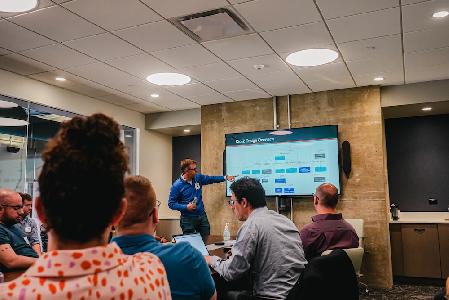But Devin Carroll, a University of Pennsylvania doctoral student in the School of Engineering and Applied Sciences, is behind a robot he made with found objects — sticks he picked up off the ground near the Pennovation Center.
It’s strung together with four AA batteries, circuitry, actuators, a microcontroller and a motor driver. And sticks, of course. The resulting device is StickBot, a modular robot that cost about $100 to make. The structure can be rearranged to move differently or achieve different goals.
The vision for StickBot is a low-cost, accessible robot that can do a variety of things, including crawling and grasping objects. Carroll’s been studying modular robotics with advisor Mark Yim, the director of the GRASP Lab at Pennovation, since 2015 when he started his graduate degree.
The concept of a found objects robot isn’t brand new to Carroll. Years ago, he began working on a flexible robot made from ice. The structure could be deployed in places like Antarctica, where you can’t often send humans to service a device. It was another example of a low-cost system that could operate in harsh environments, and it landed Carroll in the Guinness Book of World Records for the first robot made of ice in 2020. Of course, it was called IceBot.
“Trying something new because it sounds crazy isn’t the worst thing in the world,” Carroll said. “IceBot was all about brainstorming ideas, and getting actuators into the body of a robot, and same with StickBot. How do you do it cheaply in a way that wont use a lot of energy?”

Devin Carroll’s StickBot. (Courtesy photo)
Carroll also works with Michelle Johnson, director of the rehab robotics lab within the GRASP Lab. The pair have talked about potential rehabilitation use cases for StickBot, like upper arm rehabilitation, or orthotic cases. They see the potential in deploying these types of robotics in global healthcare settings, where local material could be used.
Carroll’s interest in robotics started in his undergraduate studies at the University of Massachusetts Amherst. He’d always been interested in sustainable or reusable materials, and his work with robotics at GRASP has centered on robots that can be reconfigured and parts that can be reused. While StickBot’s and other flexible robot technology can add up, it can also be reused; actuators can move from robot to robot.
“We’re trying to push that you don’t have to take new, you can recycle, you can use these materials in different ways,” Carroll said.
And he hopes that the low-cost and recyclable nature of some robots become more ubiquitous, especially for younger people and students. When he was growing up, Carroll said, robotics was not something that was introduced in a high school classroom setting, but he knows know robotics teams are becoming more commonplace. He hopes examples like IceBot and StickBot show that robotics solutions can take many forms and be more accessible than folks might think.
“It’s a question of going about reducing the cost, some schools can’t afford really expensive robotics,” Carroll said. “We’d love to give people an opportunity to have a low-cost interaction. You don’t need high-tech robotics that can fly to build a robot. You can put together an RC car to get people to start thinking about it in that way would inherently give access to students earlier.”
Join the conversation!
Find news, events, jobs and people who share your interests on Technical.ly's open community Slack

Philly daily roundup: Student-made college cost app; Central High is robotics world champ; Internet subsidy expiration looms

Philly daily roundup: Earth Day glossary; Gen AI's energy cost; Biotech incubator in Horsham

Philly daily roundup: Women's health startup wins pitch; $204M for internet access; 'GamingWalls' for sports venues


